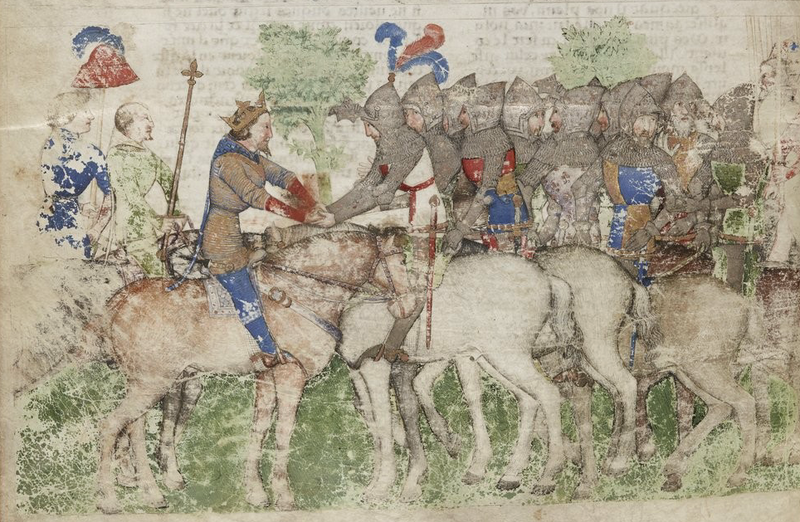Fairy Romance in the Breton Lai
Love between Mortals and Fae in Aural Medieval Tales
by Noelle Weaver
Today, we refer to love stories generally as romances, with different genres like the romantic comedy or dramas coloring the tone from goofy escapades to dramatic love confessions in the rain. However, a romance in the traditional sense doesn’t get its name because it depicts a romantic relationship; instead, it’s because of its origins in the vernacular Romance languages like French. A romance is set in the ambiguous past, often times using the familiar stage of Camelot for the story to play out in. Romances follow aristocratic characters, and the hero of the story is usually a knight going through adventures and trials to prove his honor and virtue, and often times falls in love.
One subgenre of the romance is indeed full of romantic relationships at its center, often times between humans and otherworldly fairies. These Breton lais come from Celtic oral traditions carried to Wales, and many were recorded by Marie de France. They’re brief stories, full of stock characters from fairies to jealous husbands, and with common motifs and tropes including bottomless purses, oaths between lovers, and wish children.
Out of all of these tropes, here are some of my favorites!
The Human Noble in the Locus Amoenus

The tale begins by introducing a mortal aristocrat, usually a knight or lady, and often times a member of the court of Camelot or an ambiguously familiar kingdom from long ago. This noble is marginalized or suffering in their society, and find themselves wanting for something more.
In the lai Lanval, Sir Lanval is a foreigner but also related to King Arthur. Despite his noble blood and chivalry, because of his outsider status, he’s left out of the gift giving and comradery between Arthur and the knights of Camelot. In Yonec, the lady of the story is married to an older and jealous husband, the stock character jaloux, who literally locks her in a tower away from society. The Queen of Brittany finds herself unable to have children with her husband the king in Tydorel, but he is loving and is even described as “He was never jealous of her, and she was never unworthy of him” (line 13-14), making him the antitheses of the vindictive jaloux. All three of these characters are lacking something that they’re meant to have in their position: for Sir Lanval, the property and wife that comes with knighthood, for the lady in Yonec the company of society and a loving husband, and in Tydorel the queen doesn’t have an heir to the throne.

Then that human goes to a beautiful orchard or the woods on a spring day, and enter into the locus amoenus or the ‘place of love.’ Flowers are blooming, the grass is green, and everything is fruitful again after a barren winter. It serves to set the mood for, say, a fairy lover to appear and declare their love to the human.
Sir Lanval goes out into the woods without anything except his horse, and two ladies-in-waiting appear to lead him to their queen. Her tent is made of unearthly rich materials, which “the Emperor Octavian could not have paid for one of the flaps”(85-86), and the queen is a beautiful woman dressed only in her shift and an aristocratic white ermine cloak, more beautiful than any woman on earth. Similarly, a handsome knight appears to the Queen in Tydorel when she goes to take a nap in an orchard, the usual setting of the locus amoenus.
These fabulously wealthy people may be dressed like nobility, but they are more than just a queen or a knight. They’re fairies, and while they look human, they operate on their own set of rules and values, as is seen as the stories continue on.
The Declaration of Love and the Geis

Once the fairy has appeared to the human noble, they often explain that they’ve watched the person from afar and have fallen in love with their beauty and virtues, and offer a romantic relationship to the mortal character. Not only this, but often times they also offer gifts and the children that the characters have been longing for.
The fairy knight comes to the lady in the tower in Yonec, flying into her window in the form of a hawk before revealing his true nature. He comforts her and explains his intentions, saying “Be reassured and accept me as your love… That is why I came here. I have loved you for a long time, I’ve desired you in my heart. Never have I loved any woman but you nor shall I ever love another” (ln 124-128). The lonely prisoner gains a devoted fairy knight, and the other human lovers receive both affections and material gain or children.
Sir Lanval receives an endless purse from the fairy queen to alleviate his financial troubles in Camelot. Meanwhile, the fairy knights in Yonec and Tydorel prophecy that the lady and the queen will give birth to sons. It’s never explained why these fairies inherently know the future, but this prophesying is a common occurrence in the lais.
However, these gifts don’t come for free. Much like in a normal relationship, the fairies establish a boundary or rule for the human. In Lanval the fairy queen offers her love and her endless purse to Sir Lanval, but on the condition or geis (pronounced “gesh”) that he will not tell anyone about their relationship. This seems like a strange rule, but seems to point to a realistic want for privacy. In Yonec and Tydorel these geis are less agreements and more like warnings that when the fairy knight and the lady’s relationship is found out, there will be consequences and their relationship will end. As both of these relationships are affairs outside of marriage, these are less magical and more practical; when adultery is found out, the relationship usually cannot continue on.
The human and fairy then pursue a relationship together and are happy, at least for a brief time.
The Geis is Broken

As in a horror movie when the teenagers left home alone for the weekend are told to lock the doors or not to play with a oiuja board, the audience knows that this rule will be broken and the consequences will play out badly for the main characters. Likewise, when a fairy gives their human lover the interdiction or geis, it’s only a matter of time until the human breaks it.
This plays out spectacularly badly for Sir Lanval. When Queen Guinivere is rebuked in her romantic pursuits of Lanval, she is cruel and demeans Lanval for it. Lanval loses his temper, revealing his fairy lover by telling her that the fairy queen’s lowest handmaiden is more beautiful and courtlier than Guinivere herself. He’s taken to Camelot’s court over the matter, and even worse he knows that he’s ended his relationship with the fairy queen by breaking the one rule she gave him.
In Yonec and Tydorel, the fairy lover is discovered by outsiders and the relationship comes to an end. For the lady and her knight, her jealous husband catches them and tragically kills the fairy, just as the fairy had told the lady would happen. Before the fairies leave for good or die, they tell their human lover that she will have a child. This is connected to the wish child trope, as the Queen in Tydorel couldn’t have children with her husband, and in Yonec it gives the lady trapped in the tower something good, and the fairy knight promises her that their son will avenge his murder.
The Resolution
These stories don’t always end happily, but they do resolve one way or another.
In Lanval, in a show of genuine love, the fairy queen has mercy on Sir Lanval and forgives him for breaking his promise to her. After proving that Lanval spoke the truth about the great beauty of his fairy lover, the two ride off together and are never seen in Camelot again.
Tyodrel is a darker story from the start, and it ends with the Queen’s son, Tydorel, riding off into the lake in pursuit of his father in fairyland.
Lastly, Yonec has a bittersweet ending. The fairy knight and the lady’s son is named Yonec, and when he learns the truth about how his stepfather killed his fairy father, Yonec avenges the fairy by killing the jaloux. The lady dies on the tomb of her fairy knight, and their son Yonec goes on to take his place ruling in fairyland.
It’s fascinating that all three of these stories end with the characters leaving behind the human world in favor of the fairy realm. Maybe it’s just indicative of the fabulous beauty and wealth of the fairies, with fairyland as a symbol of the state of being in love. Or maybe it has more severe judgements on the human aristocracies and society of the time which marginalize outsiders and barren women, and could allow a husband to abuse and isolate his wife. Either way, the people who are viewed as other abandon human society in the end, in the pursuit of happiness and finding somewhere they belong elsewhere.
In conclusion, these elements all seem fantastical and lacking in reason at surface glance. Upon a closer look, many are more familiar than we might realize; springtime is associated with fertility and love even today, relationships are built on trust and boundaries like a geis between lovers, and we all struggle with finding where we belong. These fantastical Breton Lais, amongst their fairies and endless purses, also show us the reality of being in society and in love.
The Lais of Marie de France, Penguin Classics ed. originally written by Marie de France and translated by Glyn S. Burgess and Keith Busby, 1986.